Original Source
..
Cosmic Microwave Background (CMB)
Doctor James Schombert
Lecture #27, May 28, 2004
Physics Department
University of Oregon
..
Cosmic
Background Radiation :
One of the foremost cosmological discoveries was the detection of the cosmic
background radiation. The discovery of an expanding Universe by Hubble was
critical to our understanding of the origin of the Universe, known as the Big Bang.
However, a dynamic Universe can also be explained by the steady state
theory.
..
The steady state theory avoids the idea of Creation by assuming that the
Universe has been expanding forever. Since this would mean that the density of
the Universe would get smaller and smaller with each passing year (and surveys
of galaxies out to distant volumes shows this is not the case), the steady-state
theory requires that new matter be produced to keep the density constant.
..
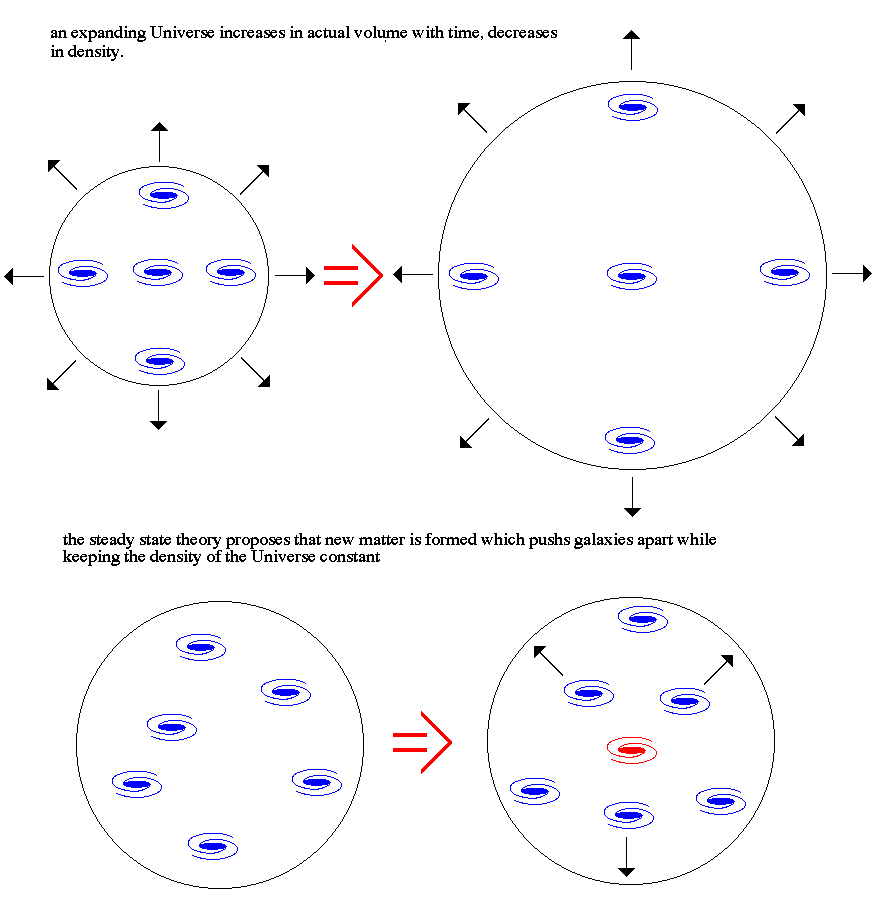
The creation of new matter would voilate the conservation of matter princple,
but the amount needed would only be one atom per cubic meter per 100 years to
match the expansion rate given by Hubble's constant.
..
The discovery of the cosmic
microwave background (CMB) confirmed the explosive nature to the origin of
our Universe. For every matter particle in the Universe there are 10 billion
more photons. This is the baryon number that reflects the asymmetry between
matter and anti-matter in the early Universe. Looking around the Universe its
obvious that there is a great deal of matter. By the same token, there are even
many, many more photons from the initial annihilation of matter and anti-matter.
..
Most of the photons that you see with your naked eye at night come from the
centers of stars. Photons created by nuclear fusion at the cores of stars then
scatter their way out from a star's center to its surface, to shine in the night
sky. But these photons only make up a very small fraction of the total number of
photons in the Universe. Most photons in the Universe are cosmic background
radiation, invisible to the eye.
..
Cosmic background photons have their origin at the matter/anti-matter
annihilation era and, thus, were formed as gamma-rays. But, since then, they
have found themselves scattering off particles during the radiation era. At
recombination, these cosmic background photons escaped from the interaction with
matter to travel freely through the Universe.
As the Universe continued to expanded over the last 15 billion years, these
cosmic background photons also `expanded', meaning their wavelengths increased.
The original gamma-ray energies of cosmic background photons has since cooled to
microwave wavelengths. Thus, this microwave radiation that we see today is an
`echo' of the Big Bang.
..

The discovery of the cosmic microwave background (CMB) in the early 1960's
was powerful confirmation of the Big Bang theory. Since the time of
recombination, cosmic background photons have been free to travel uninhibited by
interactions with matter. Thus, we expect their distribution of energy to be a
perfect blackbody curve.
A blackbody is the curve expected from a thermal distribution of photons, in
this case from the thermalization era before recombination.
..
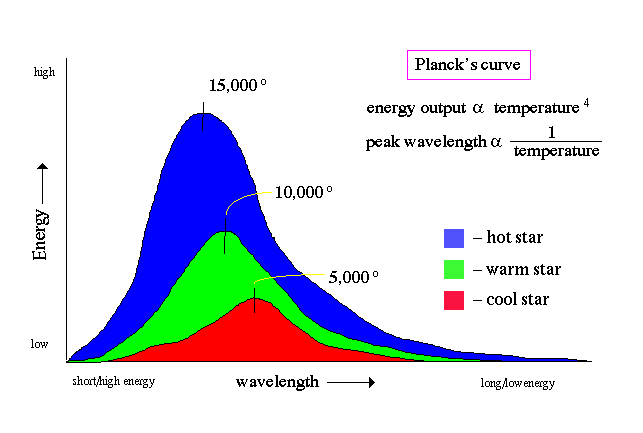
Today, based on space-based observations because the microwave region of the
spectrum is blocked by the Earth's atmosphere, we have an accurate map of the
CMB's energy curve. The peak of the curve represents the mean temperature of the
CMB, 2.7 degrees about absolute zero, the temperature the Universe has dropped
to 15 billion years after the Big Bang.
..
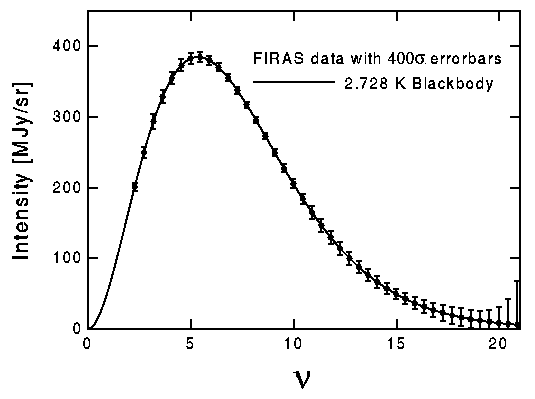
Where are the CMB photons at the moment? The answer is `all around you'. CMB
photons fill the Universe, and this lecture hall, but their energies are so weak
after 15 billion years that they are difficult to detect without very sensitive
microwave antennas.
..
Ionization:
The last stage in matter production is when the Universe cools sufficiently
for electrons to combine with the proton/neutron nuclei and form atoms. Constant
impacts by photons knock electrons off of atoms which is called ionization.
Lower temperatures mean photons with less energy and fewer collisions. Thus,
atoms become stable at about 15 minutes after the Big Bang.
..
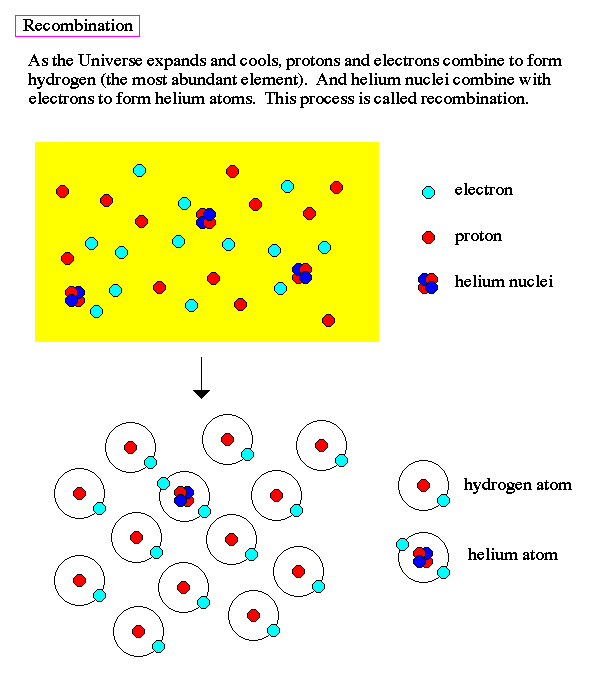
..
These atoms are now free to bond together to form simple compounds,
molecules, etc. And these are the building blocks for galaxies and stars.
..

..
Radiation/Matter Dominance :
Even after the annihilation of anti-matter and the formation of protons,
neutrons and electrons, the Universe is still a violent and extremely active
environment. The photons created by the matter/anti-matter annihilation epoch
exist in vast numbers and have energies at the x-ray level.
..
Radiation, in the form of photons, and matter, in the form of protons,
neutrons and electron, can interact by the process of scattering. Photons bounce
off of elementary particles, much like billiard balls. The energy of the photons
is transfered to the matter particles. The distance a photon can travel before
hitting a matter particle is called the mean free path.
..
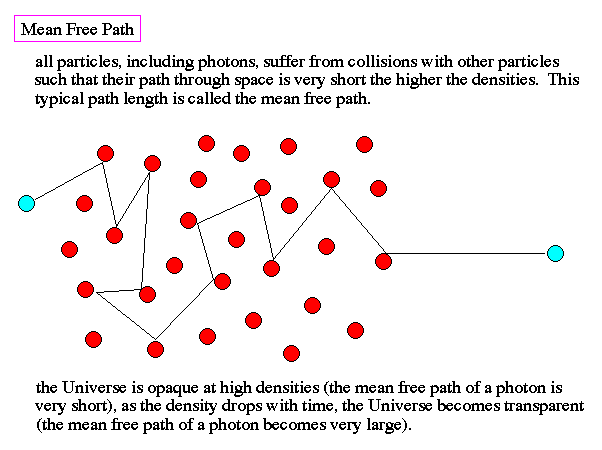
..
Since matter and photons were in constant contact, their temperatures were
the same, a process called thermalization. Note also that the matter can not
clump together by gravity. The impacts by photons keep the matter particles
apart and smoothly distributed.
..
The density and the temperature for the Universe continues to drop as it
expands. At some point about 15 minutes after the Big Bang, the temperature has
dropped to the point where ionization no longer takes places. Neutral atoms can
form, atomic nuclei surround by electron clouds. The number of free particles
drops by a large fraction (all the protons, neutrons and electron form atoms).
And suddenly the photons are free to travel without collisions, this is called
decoupling.
..
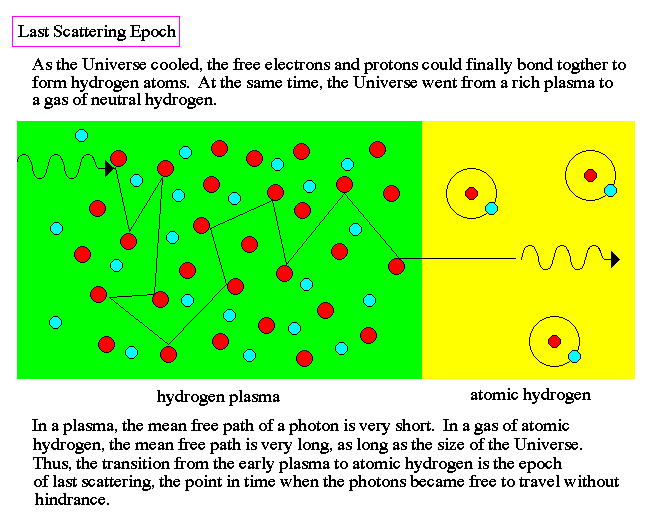
..
The Universe becomes transparent at this point. Before this epoch, a photon
couldn't travel more that a few inches before a collision. So an observers
line-of-sight was only a few inches and the Universe was opaque, matter and
radiation were coupled. This is the transition from the radiation era to the
matter era.
..

..
CMB Fluctuations :
The CMB is highly isotropy, uniform to better than 1 part in 100,000. Any
deviations from uniformity are measuring the fluctuations that grew by gravitational
instability into galaxies and clusters of galaxies.
..
Images of the CMB are a full sky image, meaning that it looks like a map of
the Earth unfolded from a globe. In this case, the globe is the celestial sphere
and we are looking at a flat map of the sphere.
..
Maps of the CMB have to go through three stages of analysis to reveal the
fluctuations associated with the early Universe. The raw image of the sky looks
like the following, where red is hotter and blue is cooler:
..
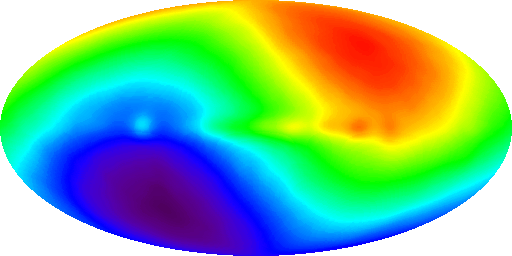
..
The above image has a typical dipole appearance because our Galaxy
is moving in a particular direction. The result is one side of the sky will
appear redshifted and
the other side of the sky will appear blueshifted. In this case, redshifting
means the photons are longer in wavelength = cooler (so backwards from their
name, they look blue in the above diagram). Removing the Galaxy's motion
produces the following map:
..
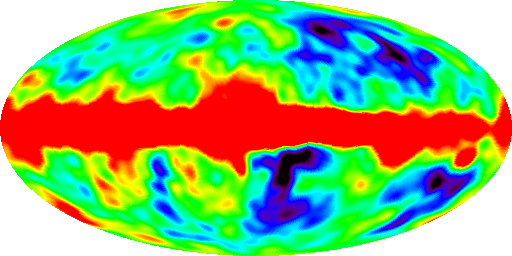
..
This map is dominated by the far-infrared emission from gas in our
own Galaxy. This gas is predominately in the plane of our Galaxy's disk, thus
the dark red strip around the equator. The gas emission can be removed, with
some assumptions about the distribution of matter in our Galaxy, to reveal the
following map:
..
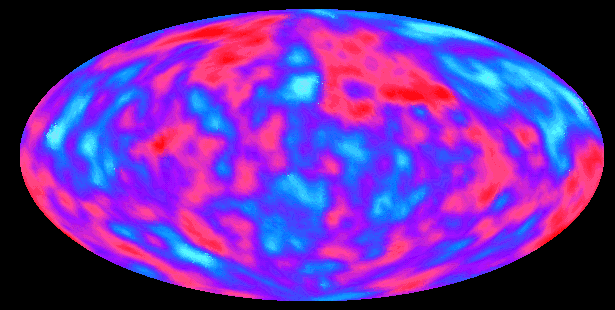
..
This CMB image is a picture of the last scattering epoch, i.e. it is
an image of the moment when matter and photons decoupled, literally an image of
the recombination wall. This is the last barrier to our observations about the
early Universe, where the early epochs behind this barrier are not visible to
us.
..
The clumpness of the CMB image is due to fluctuations in temperature of the
CMB photons. Changes in temperature are due to changes in density of the gas at
the moment of recombination (higher densities equal higher temperatures). Since
these photons are coming to us from the last scattering epoch, they represent
fluctuations in density at that time.
..
The origin of these fluctuations are primordial quantum fluctuations from the
very earliest moments of are echo'ed in the CMB at recombination. Currently, we
believe that these quantum fluctuations grew to greater than galaxy-size during
the inflation epoch, and are the source of structure in the Universe.
..
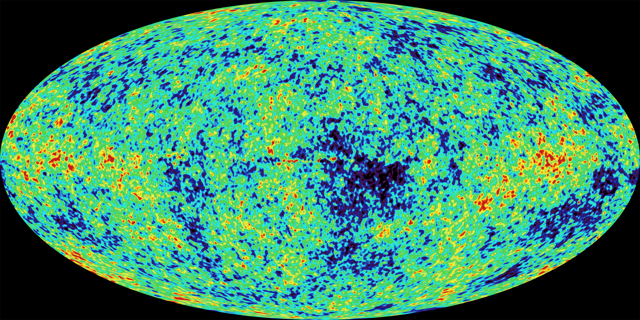
..
CMB:
When we look out in the sky, we're actually looking backwards in time. Light
from more distant objects take longer to reach us and thus we are observing now
how they appeared in the past. We can see back a few billion years with the
light of galaxies. The microwave light of the background shines from long ago in
an infant universe 300,000 years old (the epoch of "last scattering") and
illuminates the particle soup that existed before this time. This soup has a
very smooth consistency and is composed of fundamental particles like electrons,
protons, helium nuclei, neutrinos.
..
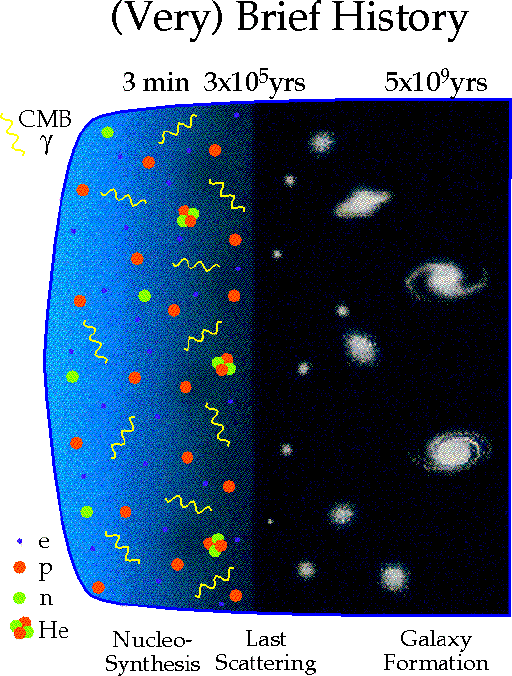
..
The obvious questions are: how did the universe go from a smooth particle
soup to a complex system of galaxies and large scale structure. Can we use the
fact that we're seeing the surface of this soup in the microwave background to
help us understand this question.
..
If we have small wrinkles or hills and valleys early on in the universe,
matter will tend to fall into the valleys, eventually producing dense regions
that become the sites of galaxies.
..
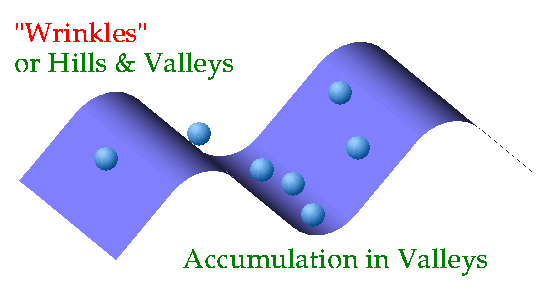
..
We represent these wrinkles by a sort of "top view" where the color coding
refers to the density of matter (dark regions have more matter, light regions
less).
..

..
Needless to say, this is a bit of an idealization for illustative purposes.
Cosmologists actually run computer simulations to track how matter collects into
valleys. For example, here is a simulation running forward in time which shows
how particles collect and enhance small initially small wrinkles.
..

..
One question that remains unanswered is what is the origin of such large
scale wrinkles in the first place. Inflation theory is that a period of rapid
expansion takes very small scale fluctuations at the level of the particle soup
and stretches them to cosmic proportions.
..
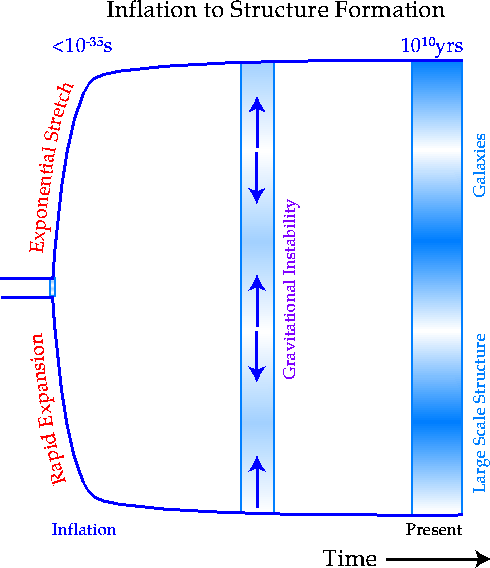
..
Here the blue bands are snapshots of the wrinkles in the density of the
universe at various times. As time goes on, matter falls into these wrinkles and
starts to build heavier and heavier objects. The crucial period when this
process of gravitational attraction and infall can occur is related to an
important concept in cosmology called the horizon. Like the horizon on the
earth, it is the point beyond which we're unable to look. Unlike the earth's
horizon, this distance is increasing with time because light from more distant
regions has had more time to reach us. Heuristically, if there is a large clump
in the universe we only know to fall toward it once it comes into the horizon.
..
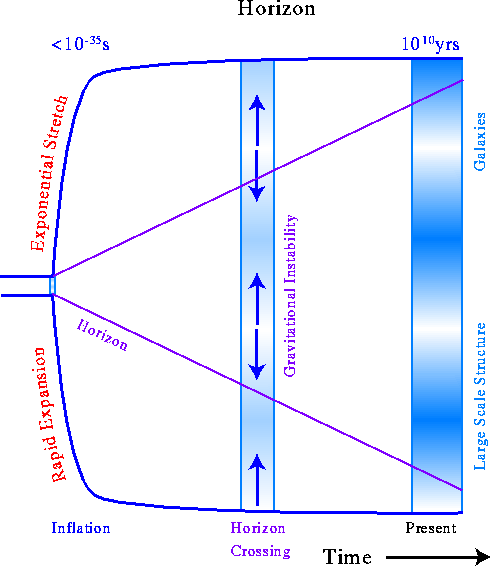
..
A useful property of the microwave background is that when we look out across
widely separated angles, we're looking at wrinkles on such large scales that
this process of infall hasn't yet begun. We're looking at the primordial
wrinkles themselves.
..
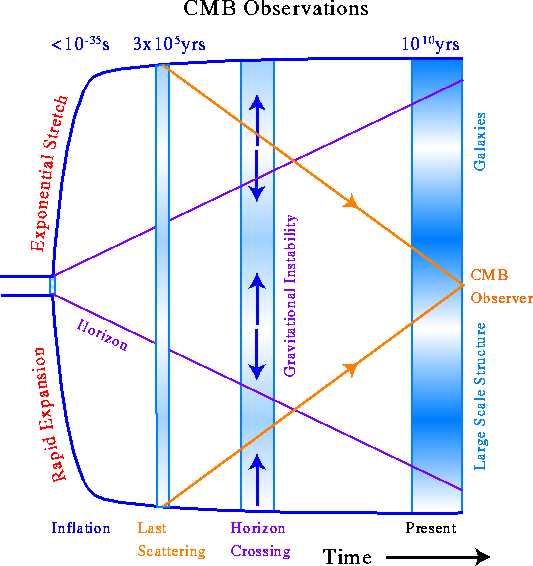
..
Small variations in the temperature of the background radiation from point to
point on the sky are called anisotropies. These anisotropies were first detected
by the COBE satellite in 1992. The current MAP version of the CMB is:
..

..
COBE and MAP then has told us what the large scale ripples in the background
radiation temperature look like. However there is much to be gained by examining
the fine details of the ripples. Recall that on the large scales, the
temperature ripples reflected the primordial ripples themselves. That is because
on scales that are larger than the horizon there hasn't been enough time for
matter to collect in the valleys and the process of structure formation to
start. When we look at smaller scales than the horizon, we see the process of
structure formation at work.
..

..
The goal of the current generation of experiments is to understand this
process in detail by looking at the small scale ripples in the background
radiation temperature.
..
What we see on small scales is actually sound. The photons behave as a gas
just like air. Ordinary sound waves are just travelling compressions and
rarefactions of the gas which we hear as sound as they strike our ear drum. The
photons also carry sound waves as gravity tries to compress the gas and pressure
resists it. The reason why we see it rather than hear it is that when we
compress the gas it becomes hotter. We see the sound waves as hot and cold spots
on the sky.
..

..
The result is a spectrum of sound waves that are useful in determining the
origin, evolution and fate of objects in the universe.
..
We think that fluctuations may have originated from a period of rapid
expansion called inflation. Whether or not this actually happened can be "heard"
in the microwave background. The fundamental tone of a musical system is related
to its physical size - here the horizon size at last scattering.
..
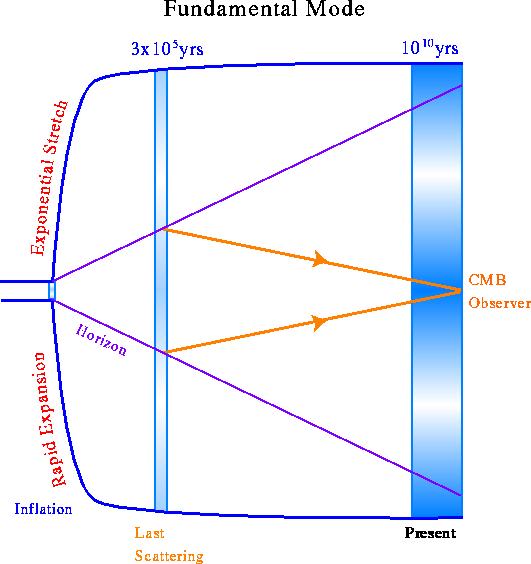
..
There is also a pattern of overtones at integer multiples of the fundamental
frequency.
..
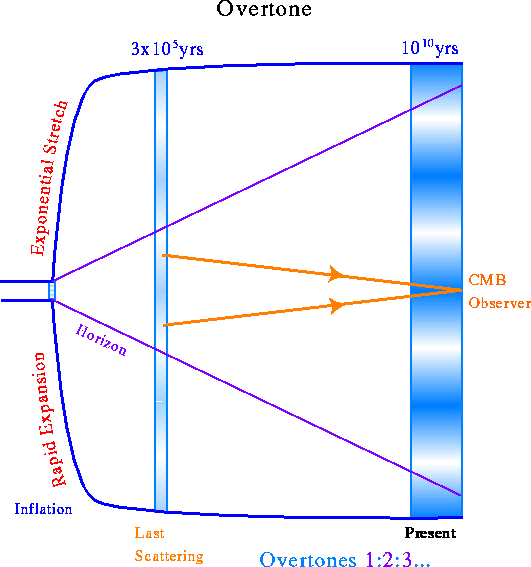
..
In music, the pattern of overtones helps us distinguish one instrument from
another: it is a kind of signature of the instrument that makes the sound. In
the same way, the pattern of overtones in the sound spectrum of the microwave
background ripples acts as a signature of inflation. Inflation's signatures are
that the overtones follow a pure harmonic series with frequency ratios of
1:2:3...
..
COBE told us what the large-scale fluctuations in the background look like,
but cosmologists today are more interested in the small-scale fluctuations.
Astronomers divide up the sky into angular degrees, so that 90 degrees is the
distance from the horizon to a point directly overhead. COBE measured
temperature ripples from the 10 degree to 90 degree scale. This scale is so
large that there has not been enough time for structures to evolve. Hence COBE
sees the so-called initial conditions of the universe. At the degree scale, on
the other hand, the process of structure formation imprints information in the
ripples about conditions in the early universe.
..
Since the COBE discovery, many ground and balloon-based experiments have
shown the ripples peak at the degree scale. What CMB experimentalists do is take
a power spectrum of the temperature maps, much as you would if you wanted to
measure background noise. The angular wavenumber, called a multipole l, of the
power spectrum is related to the inverse of the angular scale (l=100 is
approximately 1 degree). Recent experiments, noteably the Boomerang and Maxima
experiments, have show that the power spectrum exhibits a sharp peak of exactly
the right form to be the ringing or acoustic phenomena long awaited by
cosmologists:
..
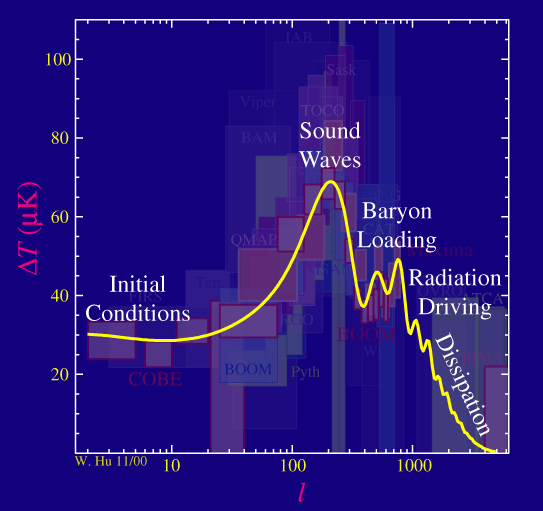
..
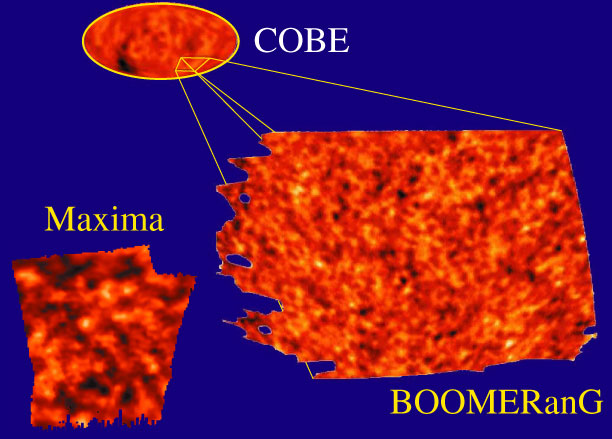
..
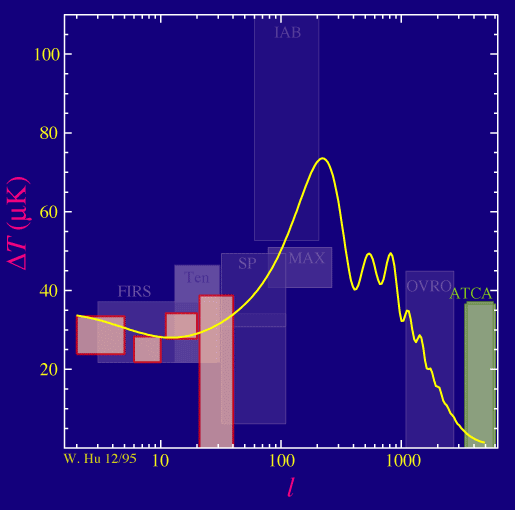
..
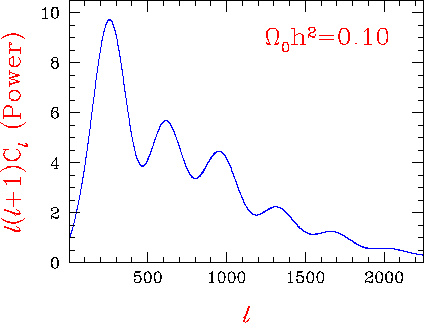
..
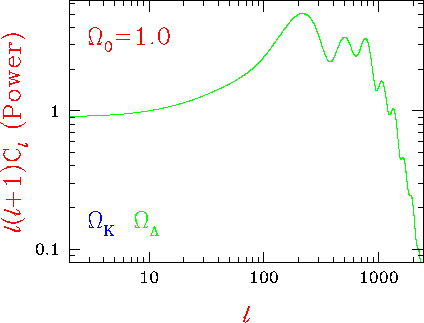
..
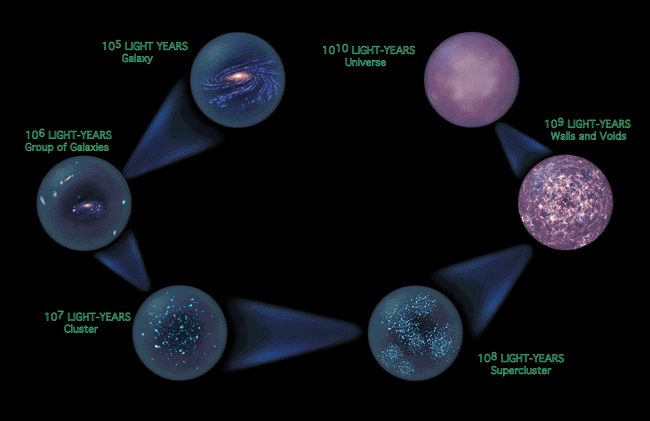
..
Origin of Structure :
As we move forward in time from the beginning of the Universe we pass through
the inflation era, baryongenesis, nucleosynthesis and radiation decoupling. The
culmination is the formation of the structure of matter, the distribution of
galaxies in the Universe.
..
During radiation era growth of structure is suppressed by the tight
interaction of photons and matter. Matter was not free to response to its own
gravitational force, so density enhancements from the earliest times could not
grow.
..
Density enhancements at the time of recombination (having their origin in
quantum fluctuations that expanded to galaxy-sized objects during the inflation
era) have two routes to go. They can grow or disperse.
..
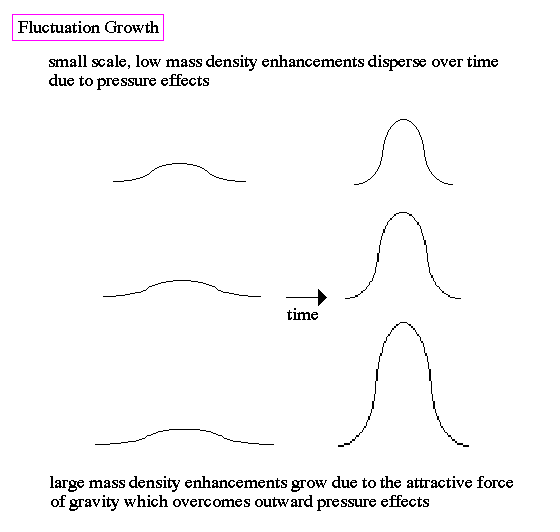
..
The `pressure effects' that density enhancements experience are due to the
expanding Universe. The space itself between particles is expanding. So each
particle is moving away from each other. Only if there is enough matter for the
force of gravity to overcome the expansion do density enhancements collapse and
grow.
..
Top-Down Scenario:
Structure could have formed in one of two sequences: either large structures
the size of galaxy clusters formed first, then latter fragmented into galaxies,
or dwarf galaxies formed first, than merged to produce larger galaxies and
galaxy clusters.
..
The former sequence is called the top-down scenario, and is based on the
principle that radiation smoothed out the matter density fluctuations to produce
large pancakes.
These pancakes accrete matter after recombination and grow until they collapse
and fragment into galaxies.
..
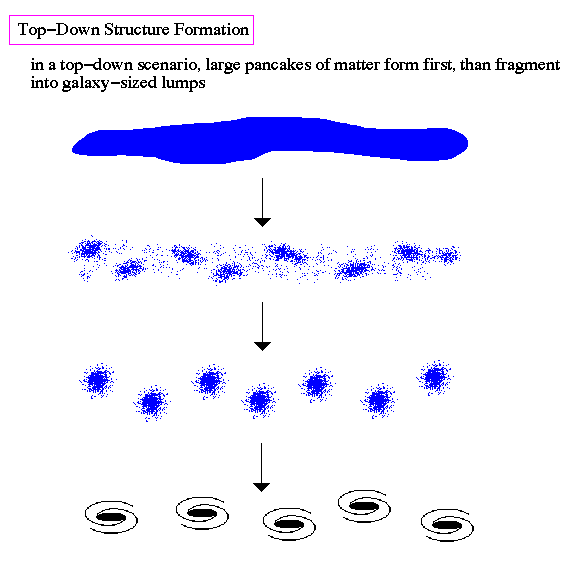
..
This scenario has the advantage of predicting that there should be large
sheets of galaxies with low density voids between the sheets. Clusters of
galaxies form where the sheets intersect.
..
Bottom-Up Scenario:
The competing scenario is one where galaxies form first and merge into
clusters, called the bottom-up scenario. In this scenario, the density
enhancements at the time of recombination were close to the size of small
galaxies today. These enhancements collapsed from self-gravity into dwarf
galaxies.
..
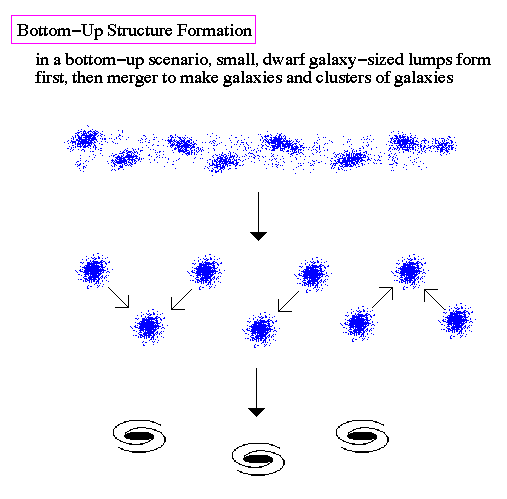
..
Once the small galaxies are formed, they attract each other by gravity and merge to form larger
galaxies. The galaxies can then, by gravity, cluster together to form filaments
and clusters. Thus, gravity is the mechanism to form larger and larger
structures.
Hot Dark Matter vs. Cold Dark Matter :
Each scenario of structure formation has its own predictions for the
appearance of the Universe today. Both require a particular form for dark
matter, a particular type of particle that makes up the 90% of the Universe not
visible to our instruments. These two forms of dark matter are called Hot and
Cold.
..
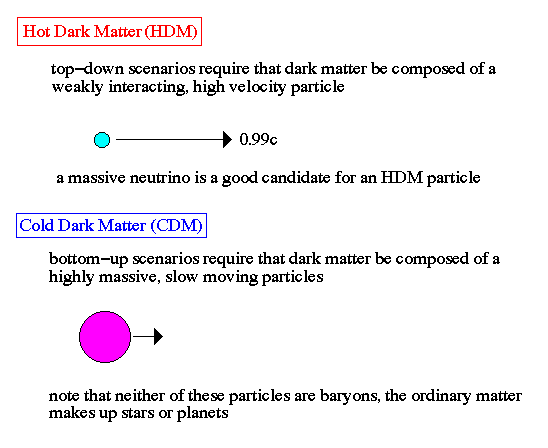
..
HDM produces large, smooth features since it travels at high velocity.
Massive neutrinos move at near the speed of light, yet interact very weakly with
matter so can serve to smooth out large density enhancements.
..
CDM, on the other hand, is slow moving and, therefore, clumps into small
regions. Large scale features are suppressed since the small clumps grow to form
small galaxies.
..
There is strong evidence that galaxies formed before clusters, in the sense
that the stars in galaxies are 10 to 14 billion years old, but many clusters of
galaxies are still forming today. This would rule against the top-down scenario
and support the bottom-up process.
..
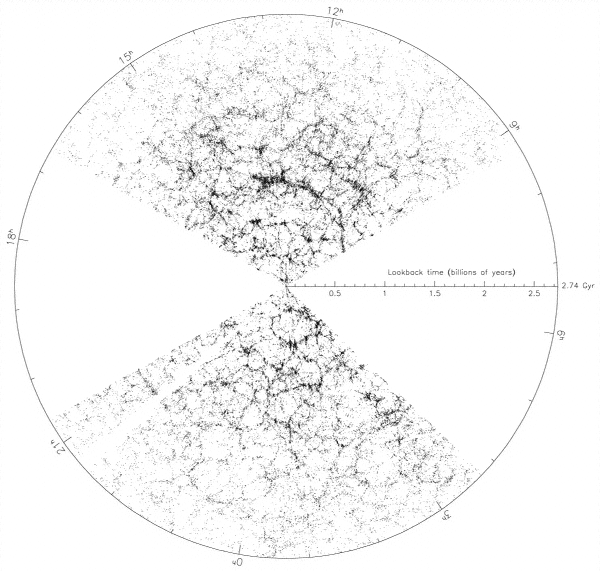
..
Large Scale Structure :
Galaxies in the Universe are not distributed evenly, i.e. like dots in a
grid. Surveys of galaxy positions, e.g. maps of galaxies, have shown that
galaxies have large scale structure in terms of clusters, filaments and voids.
..
The clusters, filaments and voids reflect the initial fluctuations at
recombination, plus any further evolution as predicted by HDM or CDM models. CDM
and HDM models have particular predictions that can be tested by maps or
redshift surveys that cover 100's of millions of light-years.
..
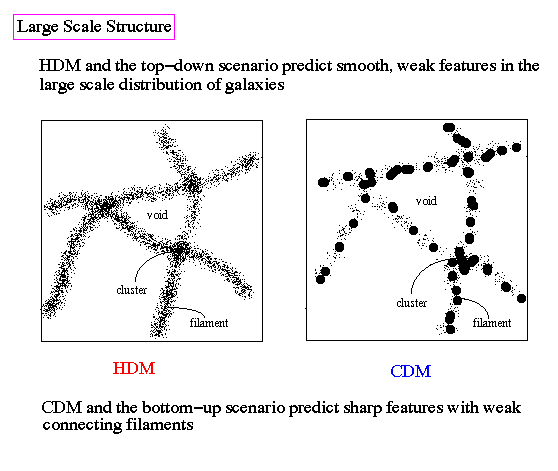
..
Interestingly enough, the real distribution of galaxies from redshift surveys
is exactly in-between the HDM and CDM predictions, such that a hybrid model of
both HDM and CDM is needed to explain what we see.
..
The mapping of large scale structure also has an impact on determining is the
Universe is open or closed. Galaxies on the edges of the filaments will move in
bulk motion towards concentrations of other galaxies and dark matter. These
large scale flows can be used to determine the density of large regions of
space, then extrapolated to determine the mean density of the Universe.







































